Lead and cotton. About the confrontation of electronics and armor
(Johann Wolfgang Goethe)
At the beginning of the year topwar.ru portal published an interesting article by Vladimir Meylitseva "Explosion on the armor." The article caused a lively discussion and has received from readers many positive ratings.
Indeed, the absence of serious structural protection on warships remains one of the most intriguing trends in modern shipbuilding. Neither USC leadership or top management of Bath Iron Works did not give any official comments and pretend as if such a problem does not exist. All decided a long time without you. Do not ask stupid questions!
Traveling across the expanses of the Internet, I accidentally discovered that the article "The explosion in the armor" was another interesting chapter ( "Why do electronics eliminates the armor?"), In which the author convincingly substantiated the thesis that the armor disappearance - an inevitable consequence of the development of electronics and rocket weapons.
The article provided several sparkling examples of the evolution of appearance fleet and related changes in ship design. But, as it seemed to me, too ordinary conclusions were made.
What happened to the cruiser "Oklahoma City"?
In the American sense, the phrase "A guy from Oklahoma," sounds about the same as we do, "Chukchi in Chukotka." However, despite all the provincialism of Oklahoma City, ship USS Oklahoma City (CL-91 / CLG-5) turned out well. Twentieth in a row cruiser "Cleveland" type Launched in February 20 1944 years.
The war soon ended, and the cruiser a great future: along with two of the same type cruisers "Oklahoma City" was selected to participate in the project "Galveston" to transform the outdated artillery ships in the carrier missile. This is where the fun began.
Sturdy armor and artillery checked fought for the right of existence of modern computers, missiles and radars!
The result was as follows:
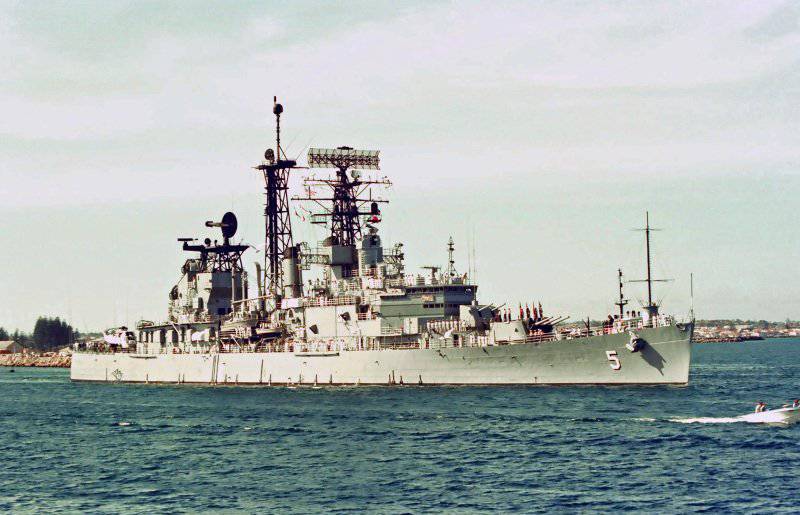
reservation scheme remained unchanged. However, the cruiser lost three towers main battery (152 mm) and five universal gauge towers (127 mm). In addition, each three-gun turrets Mk.16 170 weighed tons, excluding mechanization cellars and ammunition! Together with the towers disappeared barbettes armored and armored stern director of MSA Mk.37.
The tremendous weight savings! But that was the ship return?
Only a long-range SAM "Talos". New enhanced add-on and a couple of tall truss masts with radar - antenna leaped up to 40-odd meters above the waterline! In the aft part of the superstructure will be an additional post of guidance anti-aircraft missiles.
SAM "Talos" with ammunition 46 missile radar two coordinate air review AN / SPS-43, three-coordinate radar AN / SPS-30, viewing surface radar SPS-10A, two radars for missile guidance SPG-49. And also: a navigation radar, radio control transmitter AN / SPW-2 - only forty-seven additional antenna devices for various purposes (communications, radar, transponders, beacons, EW means).
So what finally happened to the "Oklahoma"?
The answer is obvious - the only air defense system and equipment of a new generation of "ate" whole load reserve, which arose after the removal of 3 / 4 artillery GC and five towers with twin universal tool! But it was not enough. The electronics modules required significant volumes to accommodate them - the cruiser "swollen" and repeatedly increased in size superstructure.
It turns out that electronic systems and rocket weapons are the main load items in the design of modern ships!
In general, this is a wrong conclusion. And that's why:
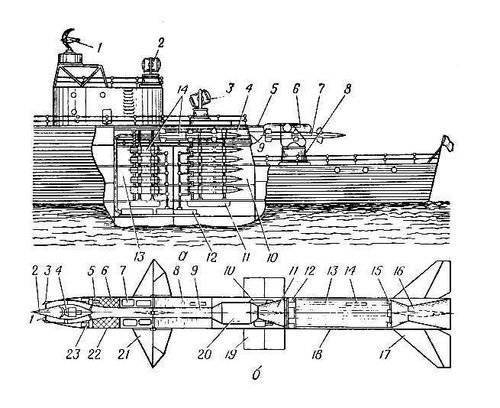
God forgive me, Vladimir Meylitsev, but given in his article SAM "Talos" storage of ammunition and supply circuit looks like a mockery of a unique complex that 20 years had no analogues in the world's oceans.
"Talos" missiles were stored disassembled. Before the start of the required dock warhead missiles with a marching step on liquid fuel, and then attach the two-ton solid rocket booster. Length superrakety assembled reached 9,5 meters. As you understand, installation and transportation of such a complex and cumbersome system was not a trivial task. As a result, the stern of "Oklahoma" has become a huge rocket shop!
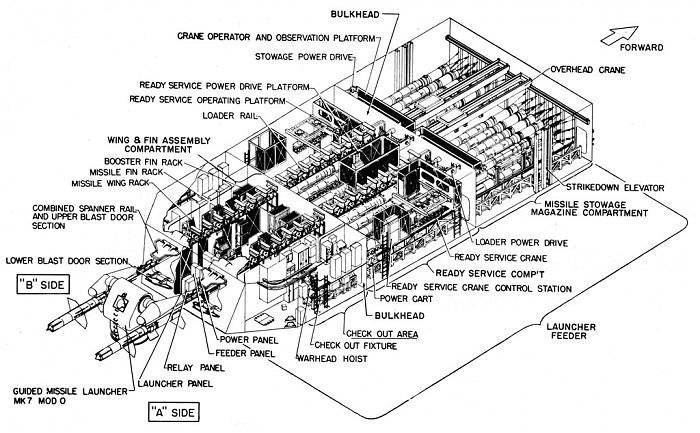
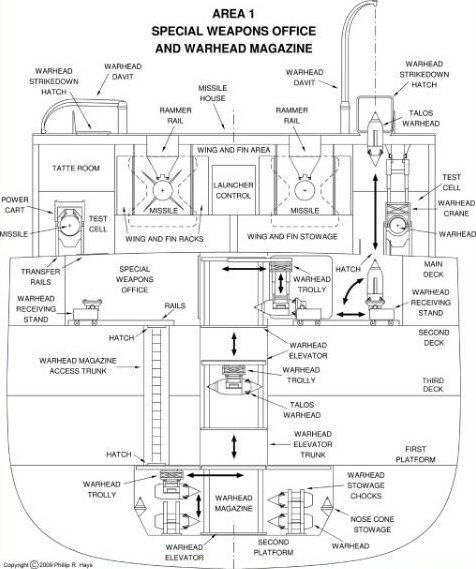
Cruiser-museum "Little Rock" also upgraded on the avenue. "Galveston"
Mark-7 storage and prelaunch system consisted of an armored hopper on the upper deck (wall thickness 37 mm hatches protected from the blast), as well as from the system deck spaces intended for loading, storage and transport of warheads in prelaunch ZUR zone . Tunnels, trolley, room for inspection and testing SBCH, elevator shaft, penetrating the ship to the bottom - combat troops "Talos", including in nuclear performance, were stored in the cellar below the waterline. Also, the complex includes a bulky launcher - dvuhbalochnye swivel pedestal, and its actuators in below deck.
Everything related to "Talos" can cause a shock. The complex is so huge that no one has ever built such monsters.
The starting mass of the Talos rocket is 3,5 tons. This is twice as heavy as any modern missiles!
The hard truth of the cruiser "Oklahoma City" was the fact that on board was installed long-range air defense missile system that is based on technology 50-ies. All electronics on lamps, heaviest radar, primitive rocket technology, bulky storage and preparation for the launch, ancient computers that occupied entire rooms ... It is not surprising that the installation "Talos" Americans had to dismantle the eight gun turrets!
Do not forget about the excessively high mast with massive antenna devices, enhanced add-on as well as the dubious idea of a missile storage of ammunition in a bunker on the upper deck. To compensate for these factors and their negative impact on the stability (CM displacement, windage, etc.) along the keel "Oklahoma" was laid a few hundred tons of additional ballast!
And yet, in spite of the outdated technology, the Americans were able to create a full-missile artillery cruiser. "Talos" (firing range 180 km from the modification of RIM-8C) with a powerful complex. And to keep the nasal artillery group (two towers with five- and six-inch guns) and structural protection that included 127 bronepoyas mm and horizontal booking (deck №3 50 mm thick).
Total displacement of the modernized "Oklahoma City" has reached the value 15200 tons - on 800 tons heavier than the original design. However, the cruiser suffered from a small reserve of stability and even dangerous turn in a weak storm. The problem was solved part of the dismantling of the secondary equipment and laying of the superstructure along the keel 1200 tons additional ballast. Sediment has increased by more than 1 meter. Total displacement exceeds 16 thousand. Tons! In principle, the price paid was small - with a view of the "compactness" tube electronics, masts incredible heights and surprising SAM "Talos".
As the destroyer "Ferregat" turned into a cruiser "Leahy"
Another shining example of V. Meylitseva!
So, there lived a destroyer USS Farragut (DDG-37) - head in a series of 10 ships under construction at the turn of 50-60-ies. Very large destroyer and a half times the size of all of their peers - its total displacement was 6200 tons!
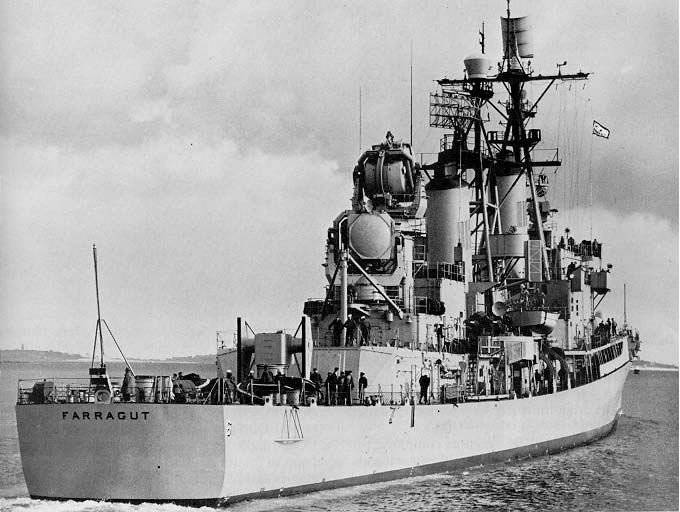
"Ferregat" was one of the first carriers of missile in the world. In the stern of the destroyer was installed SAM average "Terriers" range (effective range - 40 km, very solidly by the standards of those years) with ammunition 40 missiles. Also in the arms of the destroyer was part PU raketotorped "ASROK" weapon systems and highly automated Mk.42 caliber 127 mm.
Reservation "Ferregat" had.
Where is the "trick" here? The real intrigue begins with the appearance on the horizon of escort cruiser USS Leahy (CG-16).
Despite the difference in the classification, "Leahy" and "Ferregat" have much in common - the same powerplant output, a set of radar, weapons ... The main difference - the cruiser carried a two SAM "Terriers" (the total ammunition - 80 SAM). Otherwise, the cruiser and the destroyer looked like twins.
At the same time, the full displacement of the "Lega" reached 8400 tons!
Here it is, the detrimental effects of missiles and electronics to the design of modern ships! Installation of additional SAM increased the displacement of the ship on more than two thousand tons (30% of the total in the / "Ferregata"). What kind of armor can we talk about, if his weapon barely fits his weapon?
This erroneous conclusion. In his arguments, we have missed some important details.
The first obvious strangeness "Ferregat" was too much for the class displacement (by the standards of 50-x) - 6200 tons! In parallel with the "Ferregatom" in the United States build another series of missile destroyers - "Charles F. Adams." 4500 tons.
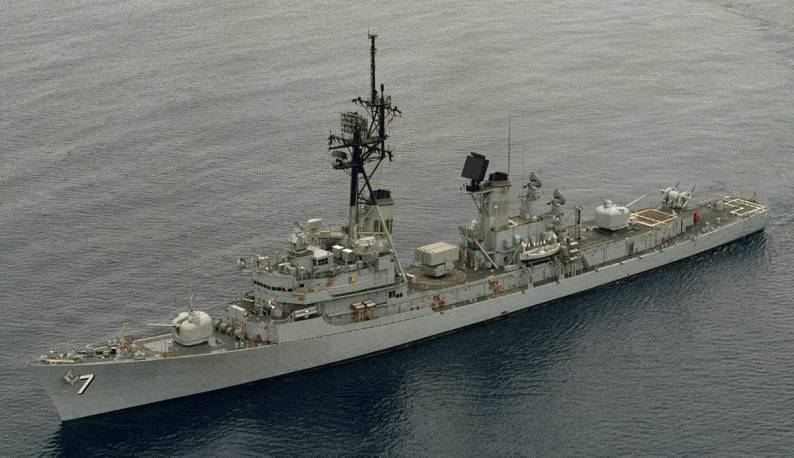
"Adams" was armed with a short-range Tartar SAMs (ammunition - 42 missiles without a launch accelerator). However, the smaller mass of the "Tartarus" was successfully offset by the installation of an additional 60-tonne gun Mk.42 ("Adams" carried two instead of one on the "Ferregat"). The box "ASROK" was present on both ships without changes. The differences in the characteristics of the radar in this case do not matter - both ships were equipped with bulky electronics.
The difference in 1700 tonnes of displacement is difficult to explain only with rockets and electronics. It is worth paying attention to the following important factors: “Ferregat” plant was at 15 ths. Hp more powerful powerplant "Adams". In addition, "Farregat" had greater speed and range. And most importantly, the destroyer was a "remake": "Farregat" was created as a high-speed anti-submarine ship with classical artillery, torpedoes and rocket bombers. As a result, he had a non-rational layout, in contrast to the “Adams”, which was originally designed as a missile destroyer.
Everything is not easy here ...
As for the comparison of the cruiser and the destroyer, it clearly shows that “electronics and rockets” are not the dominant articles of the load when designing modern ships. It is strange that the author did not pay any attention to this.
First, Lega was created as a cruiser to accompany aircraft carrier groups at any distance from the coast and had a tremendous cruising range — 8000 miles on 20 nodes (for comparison, the cruising range of Ferregat, from various sources, varied from 4500 to 5000 miles on 20 knots.). Simply put, Leahie was forced to carry additional 500-700 tons of fuel.
But all this is nothing compared to the main thing!
"Adams", "Farregat", "Legs" and other masterpieces of that era were miniature "pelvis", the largest of which ("Legs") were half the size of World War II cruisers!
No missiles and bulky lamp electronics could compensate for the lack of armor and artillery. The firstborn of the "rocket era" rapidly "shrank" in size.

The table is not entirely correct. First, ships of different classes are compared - the 3000 ton Fletcher and the 9000 ton Belknap. So the extra 150 tons of electronics for Belknap is like a grain bastard. As well as additional 400 cubic meters of space for its placement. And, as already noted, the radio electronics of those years was not very compact.
Equally unreasonable is the reference to the increase in energy consumption of new equipment. Just look at the required power of the GEM ships of the Second World War and compare them with the same "Leahy". The American - 85 000 hp A similar in size Soviet light cruiser of the 26 Ave. “Maxim Gorky” (1940 g.) Had hp on the shafts of 130 000 propellers! So much power was needed to accelerate the ship to speed 37 nodes.
In the coming era of rocket weapons, this speed proved to be useless. The released reserve of load and free space was successfully spent on the deployment of an additional ship power station and switchboards.
That's right. But it is worth remembering that the atomic frigate Bainbridge was half the size of the Des Moines.
Finale
“Farregat”, “Adams”, “Legs”, “Bainbridge” - all considered examples are ancient vessels of the beginning of the Cold War.
How much have radar and electronics evolved today? How have rockets and fire controls changed? Does the Talos armored cellar look like a compact decking UVP? (for this purpose, a comparison of the modern Mk.41 with the beam Mk.26 PU from 70-s is indicative). What is the difference between steam turbine GEM on fuel oil and modern gas turbine?
New technologies in design, new welding methods, new materials and alloys, ubiquitous ship automation (for comparison, the Oklahoma crew consisted of 1400 sailors; modern Zamvolt and Type 45 cost only a couple of hundred).
The German frigate "Hamburg" model 2004 g. Full displacement - 5800 tons. A small faceted turret in the nose of the superstructure duplicates all the giant antennas that were installed on the ships of previous years: detection of air and surface targets, navigation, artillery fire correction, flight control of missiles, target illumination — the only multifunctional AFAR radar with 4 active FAR operates everything . The anthracite-black SMART-L long-range radar is visible in the rear of the superstructure. This thing sees satellites in low earth orbit. "Oklahoma" with its cumbersome radars did not stand close by
Such things give a cumulative effect of reducing the main articles of the load ships. The appeared reserve was successfully spent on increasing the area of residential premises, new-fashioned gyms / fitness centers and the transformation of a warship into a brothel. In addition to “inflating” add-ons, the reserve was spent on any customer's whims: if you wish, you can shove several hundred samples of rocket weapons onto a modern ship (for example, the South Korean "King Shogeng"), install any radar, or leave room free — to save money in peacetime .
Much has already been written about the need to equip modern ships with armor. Let me quote three main points:
1. The armor was removed due to the threat of imminent nuclear war. The third world didn’t happen, and the trouble-free "pelvis" as a result turned out to be easy victims in modern local conflicts.
2. The existence of a reservation scheme similar to the schemes used in the most advanced and rational design cruisers of the time of WWII (for example, the Baltimore-type TKR, adjusted for new technologies), today excludes heavy ship damage in the war with the Third World countries. And to the utmost it makes it difficult to defeat him by means of an air attack in a fight with an opponent of equal strength.
3. Installing armor will undoubtedly increase the displacement of the ship and its cost (up to 30%, taking into account the hull volumes necessary to maintain the same stability). But what does an additional pair of hundreds of millions mean when the ship’s “filling” is worth billions?
In this case, an armored cruiser can not be disabled by a single explosion. He will not be able to knock out suicidal fanatics on a leaky feluge. Yes, and most modern samples of RCC will be powerless in front of an armored monster.
The lack of armor on modern ships is not a consequence of any constructive limitations. It is dictated by the personal interests of the naval leadership of the leading countries of the world (USA, Japan, NATO). Countries that are able to build a warship with a displacement of 10-15 th. Tons, are not interested in the appearance of Neo-Carriers. The appearance of such a ship will instantly make all 84 American "Ticonderoga" and "Orly Burk."
“You have to be the greatest fool to encourage developments that give nothing to a country that already has absolute dominance at sea. Moreover, if they succeed, we can lose this domination ... ”(British Admiral Lord Jervis about the testing of a current submarine model, 1801 year).
PS In the title illustration of the article - BOD (patrol ship) of the 61 project. The total displacement is 4300 tons. The technical design of this BOD was approved in 1958 year - because the watchdog seems overloaded with giant antennas.
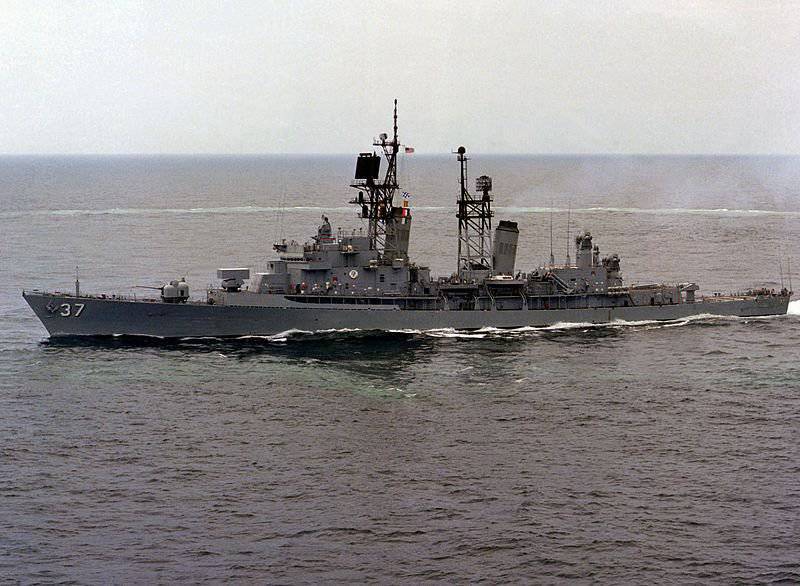
Based on:
http://bwana.ru
http://forum.worldofwarships.ru
http://navsource.org
http://okieboat.com
http://wikipedia.org
http://wunderwafe.ru
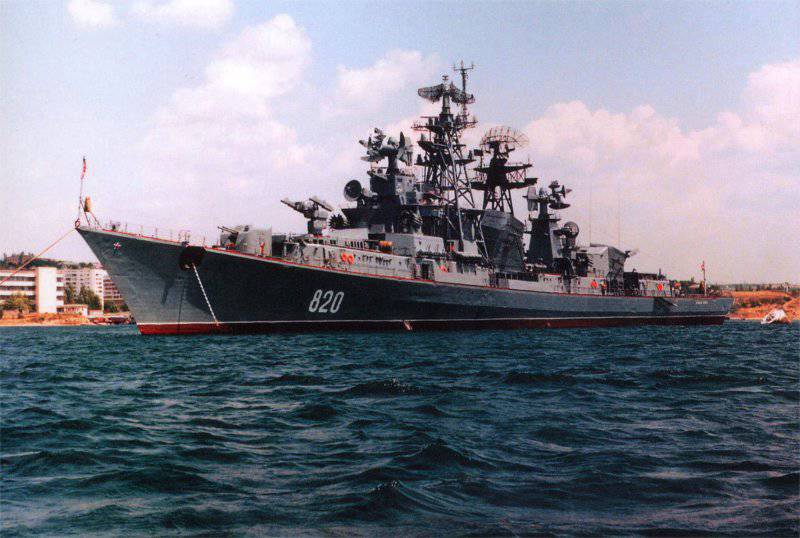
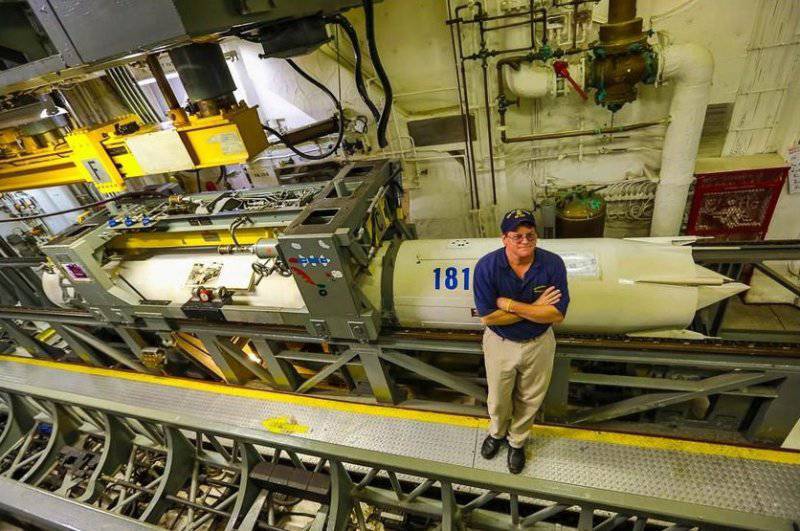
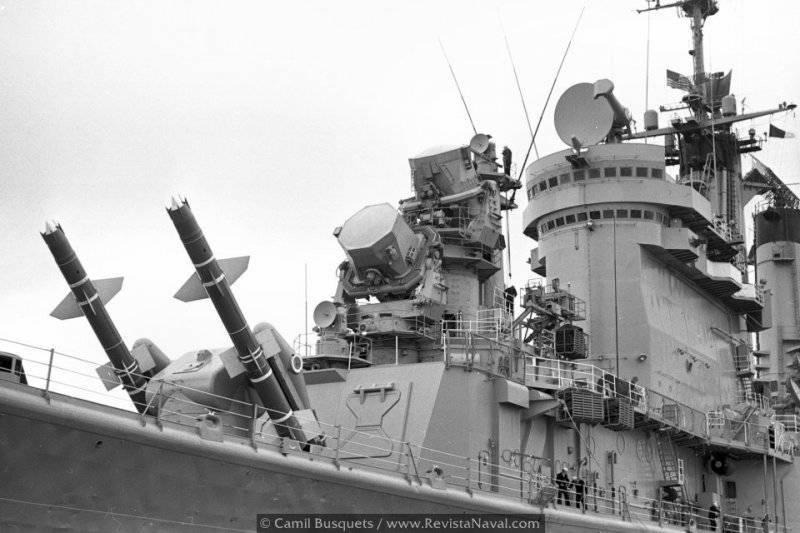
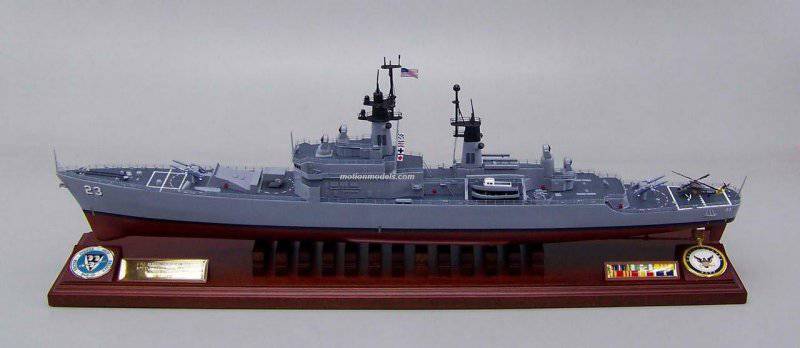
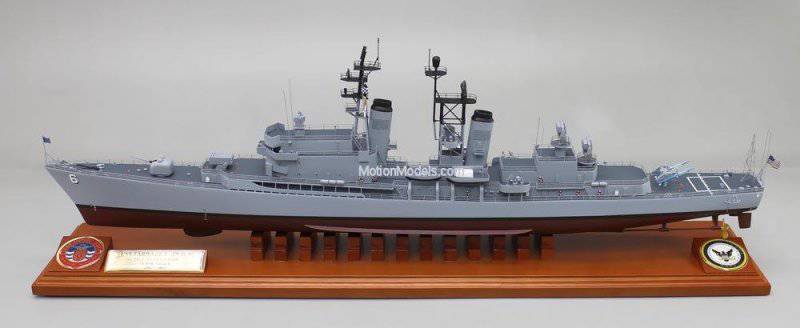
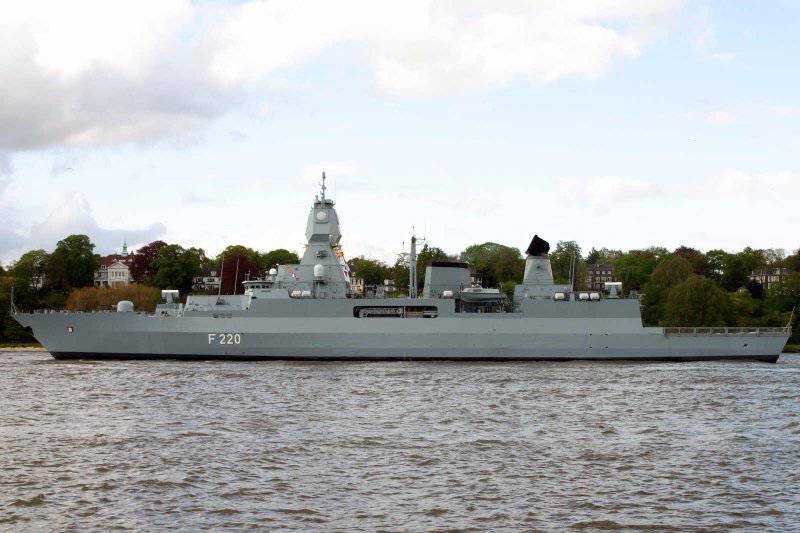
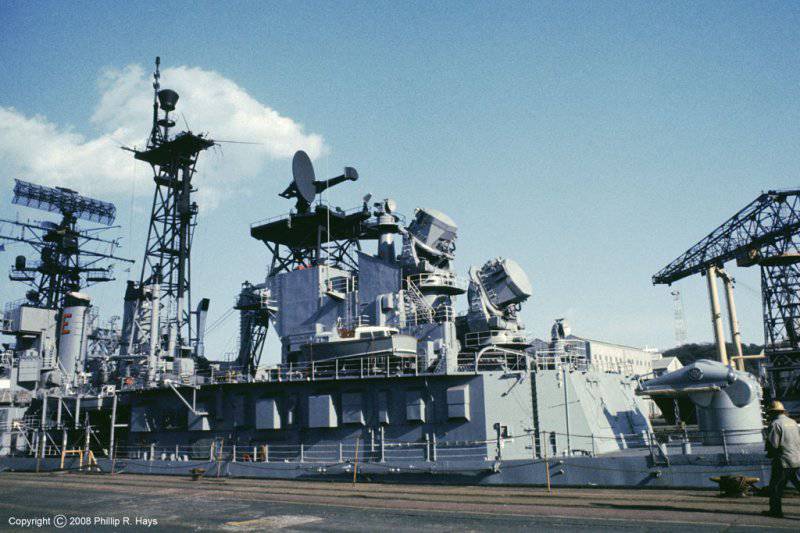
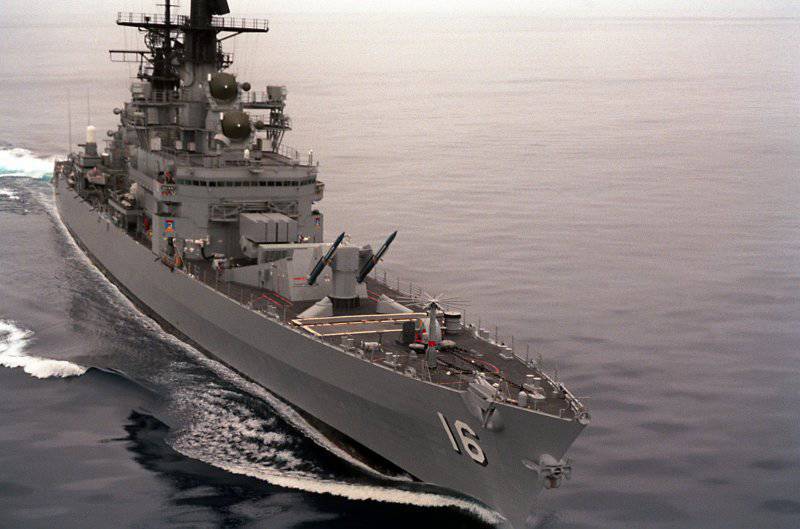
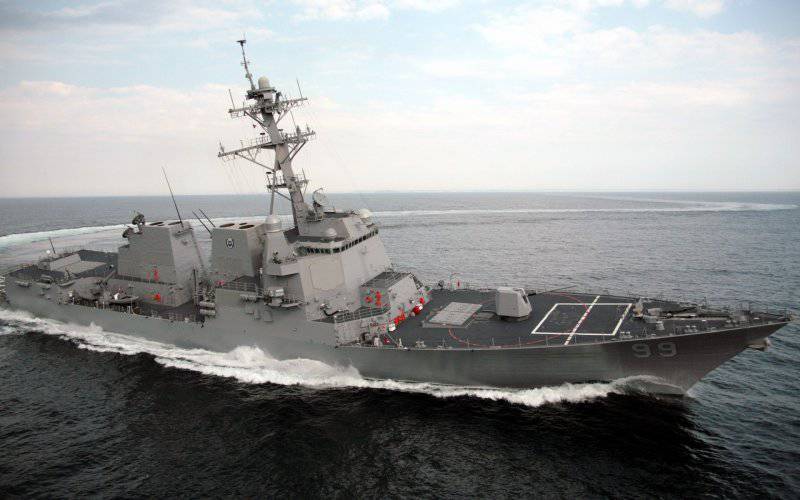
Information